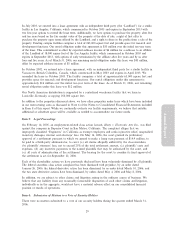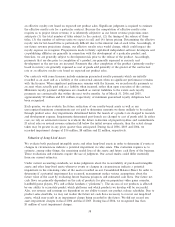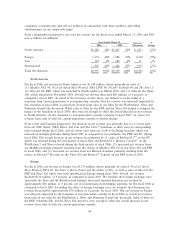Electronic Arts 2006 Annual Report Download - page 108
Download and view the complete annual report
Please find page 108 of the 2006 Electronic Arts annual report below. You can navigate through the pages in the report by either clicking on the pages listed below, or by using the keyword search tool below to find specific information within the annual report.
Stock-Based Compensation. On April 2, 2006, the Ñrst day of our current Ñscal year, we adopted
SFAS No. 123R, ""Share-Based Payment'', which requires us to recognize compensation expense for all
stock-based compensation based on estimated fair values. As a result, beginning with our Ñrst quarter of
Ñscal 2007, our operating results will contain a charge for stock-based compensation related to the equity-
based compensation we provide to our employees, as well as stock purchases under our 2000 Employee
Stock Purchase Plan. This expense will be in addition to the stock-based compensation expense we have
recognized in prior periods related to restricted stock unit grants, acquisitions and other grants. The stock-
based compensation charges we incur will depend on the number of equity-based awards we grant, the
number of shares of common stock we sell under our 2000 Employee Stock Purchase Plan, as well as a
number of estimates and variables such as estimated forfeiture rates, the trading price and volatility of our
common stock, the expected term of our options, and interest rates. As a result, our stock-based
compensation charges can vary signiÑcantly from period to period. The expensing of stock-based
compensation will have a material adverse impact on our Consolidated Statements of Operations and may
not be similar to our pro forma disclosure under SFAS No. 123, as amended.
CRITICAL ACCOUNTING POLICIES AND ESTIMATES
Our Consolidated Financial Statements have been prepared in accordance with accounting principles
generally accepted in the United States. The preparation of these Consolidated Financial Statements
requires management to make estimates and assumptions that aÅect the reported amounts of assets and
liabilities, contingent assets and liabilities, and revenue and expenses during the reporting periods. The
policies discussed below are considered by management to be critical because they are not only important
to the portrayal of our Ñnancial condition and results of operations but also because application and
interpretation of these policies requires both judgment and estimates of matters that are inherently
uncertain and unknown. As a result, actual results may diÅer materially from our estimates.
Revenue Recognition, Sales Returns, Allowances and Bad Debt Reserves
We principally derive revenue from sales of packaged interactive software games designed for play on
video game consoles (such as the PlayStation 2, Xbox, Xbox 360 and Nintendo GameCube), PCs and
mobile platforms including handheld game players (such as the Sony PSP, Nintendo DS and Nintendo
Game Boy Advance) and cellular handsets. We evaluate the recognition of revenue based on the criteria
set forth in Statement of Position (""SOP'') 97-2, ""Software Revenue Recognition'', as amended by
SOP 98-9, ""ModiÑcation of SOP 97-2, Software Revenue Recognition, With Respect to Certain
Transactions'' and StaÅ Accounting Bulletin (""SAB'') No. 101, ""Revenue Recognition in Financial
Statements'', as revised by SAB No. 104, ""Revenue Recognition''. We evaluate revenue recognition using
the following basic criteria and recognize revenue when all four of the following criteria are met:
‚ Evidence of an arrangement: Evidence of an agreement with the customer that reÖects the terms
and conditions to deliver products must be present in order to recognize revenue.
‚ Delivery: Delivery is considered to occur when the products are shipped and risk of loss and reward
have been transferred to the customer. For online games and services, revenue is recognized as the
service is provided.
‚ Fixed or determinable fee: If a portion of the arrangement fee is not Ñxed or determinable, we
recognize that amount as revenue when the amount becomes Ñxed or determinable.
‚ Collection is deemed probable: At the time of the transaction, we conduct a credit review of each
customer involved in a signiÑcant transaction to determine the creditworthiness of the customer.
Collection is deemed probable if we expect the customer to be able to pay amounts under the
arrangement as those amounts become due. If we determine that collection is not probable, we
recognize revenue when collection becomes probable (generally upon cash collection).
Determining whether and when some of these criteria have been satisÑed often involves assumptions and
judgments that can have a signiÑcant impact on the timing and amount of revenue we report. For
36
























